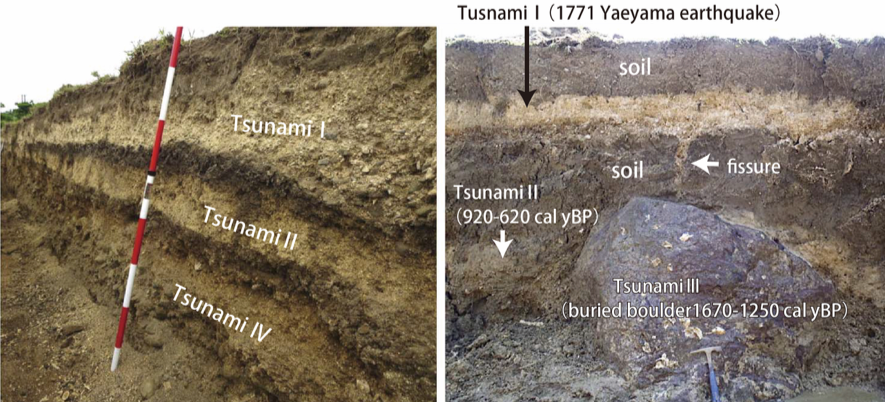The southern Ryukyu Islands have been repeatedly hit by gigantic tsunamis-the study proves
Summary of AIST Press Release on December 4, 2017Japanese
A research group including Masanobu Shishikura (Subduction Zone Paleoearthquake Research Group) has revealed the occurrence of four paleotsunamis in the area based on the study of sandy tsunami deposits and published their results online in Tectonophysics in December 2017.
The 1771 Yaeyama earthquake, the biggest ever known one occurred along the Ryukyu trench, caused a 30-meter-high tsunami and gave enormous damage to the southern Ryukyu Islands, killing twelve thousand locals.
The mechanism of the tsunami has been studied mainly with tsunami boulders, which can tell us the scale and history of past tsunamis but not the limit of tsunami inundation. On the other hand, sandy tsunami deposits provide powerful clues to the answer. This time, in a trenching survey on the Ishigaki Island, their distribution has been precisely determined for the first time, and it is shown that four earthquakes as large as the one in 1771 have hit the area almost every six centuries in the past 2000 years.
The survey also showed a new aspect of the 1771 earthquake. It has been thought to be a "tsunami earthquake" which causes much bigger tsunami than expected from the relative weakness of its seismic shaking. But judging from the numbers of cracks found in the trench, it is suggested that the earthquake was an ordinary gigantic one with violent tremors.
The outcome will serve as useful scientific knowledge for the disasters prevention planning in the area.
Left: Tsunami deposits I, II and IV (light color) on the wall of the trench. Right: Tsunami deposits I and II and a buried andesite boulder (Tsunami III). Ages of the tsunami deposits were determined by 14C dating methods.
A fissure in a dark brown soil is filled with the sediment of deposit I.
Publication details
Ando, M., A. Kitamura, Y. Tu, Y. Ohashi, T. Imai, M. Nakamura, R. Ikuta, Y. Miyairi, Y. Yokoyama and M. Shishikura (2018) Source of high tsunamis along the southernmost Ryukyu trench inferred from tsunami stratigraphy. Tectonophysics, 722, 265-276.


